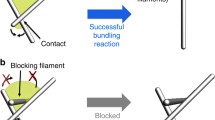Abstract
Control of the structure and dynamics of the actin cytoskeleton is essential for cell motility and for maintaining the structural integrity of cells. Central to understanding the control of these features is an understanding of the dynamics of actin filaments, first as isolated filaments, then as integrated networks, and finally as networks containing higher-order structures such as bundles, stress fibers and acto-myosin complexes. It is known experimentally that single filaments can exhibit large fluctuations, but a detailed understanding of the transient dynamics involved is still lacking. Here we first study stochastic models of a general system involving two-monomer types that can be analyzed completely, and then we report stochastic simulations on the complete actin model with three monomer types. We systematically examine the transient behavior of filament length dynamics so as to gain a better understanding of the time scales involved in reaching a steady state. We predict the lifetime of a cap of one monomer type and obtain the mean and variance of the survival time of a cap at the filament end, which together determine the filament length fluctuations.
Similar content being viewed by others
References
Abramowitz M, Stegun I (1965) Handbook of mathematical functions
Alexander M, Oster G (1996) Cell motility driven by actin polymerization. Biophys J 71(6): 3030–3045
Bugyi B, Carlier MF (2010) Control of actin filament treadmilling in cell motility. Annu Rev Biophys 39: 449–470
Carlier MF, Pantaloni D, Korn ED (1986) The effects of Mg2+ at the high-affinity and low-affinity sites on the polymerization of actin and associated ATP hydrolysis. J Biol Chem 261: 10785–10792
Carlsson AE (2008) Model of reduction of actin polymerization forces by ATP hydrolysis. Phys Biol 5(3): 1–9
De La Cruz EM (2009) How cofilin severs an actin filament. Biophys Rev 1: 51–59
Dickinson RB, Caro L, Purich DL (2004) Force generation by cytoskeletal filament end-tracking proteins. Biophys J 87: 2838–2854
Doorn van EA (2001) Representations for the rate of convergence of birth-death processes. Memorandum No. 1584, University of Twente
Fass J, Pak C, Bamburg J, Mogilner A (2008) Stochastic simulation of actin dynamics reveals the role of annealing and fragmentation. J Theor Biol 252(1): 173–183
Footer MJ, Kerssemakers JWJ, Theriot JA, Dogterom M (2007) Direct measurement of force generation by actin filament polymerization using an optical trap. PNAS 104(7): 2181–2186
Fujiwara I, Takahashi S, Tadakuma H, Funatsu T, Ishiwata S (2002) Microscopic analysis of polymerization dynamics with individual actin filaments. Nat Cell Biol 4(9): 666–673
Fujiwara I, Vavylonis D, Pollard TD (2007) Polymerization kinetics of adp- and adp-pi-actin determined by fluorescence microscopy. PNAS 104(21): 8827–8832
Goel NS, Richter-Dyn N (1974) Stochastic models in biology. Academic, New York
Hill TL (1986) Theoretical study of a model for the ATP cap at the end of an actin filament. Biophys J 49(5): 981–986
Hotulainen P, Hoogenraad CC (2010) Actin in dendritic spines: connecting dynamics to function. J Cell Biol 189(4): 619–629
Hu J, Matzavinos A, Othmer HG (2007) A theoretical approach to actin filement dynamics. J Stat Phys 128(1–2): 111–138
Kuhn JR, Pollard TD (2005) Real-time measurements of actin filament polymerization by total internal reflection fluorescence microscopy. Biophys J 88(2): 1387–1402
Marcy Y, Prost J, Carlier MF, Sykes C (2004) Forces generated during actin-based propulsion: a direct measurement by micromanipulation. PNAS 101(16): 5992–5997
Matzavinos A, Othmer HG (2007) A stochastic analysis of actin polymerization in the presence of twinfilin and gelsolin. J Theor Biol 249(4): 723–736
McGrath JL, Osborn EA, Tardy YS, Dewey CF Jr, Hartwig JH (2000) Regulation of the actin cycle in vivo by actin filament severing. PNAS 97(12): 6532–6537
Mitchison T, Kirschner M (1984) Dynamic instability of microtubule growth. Nature 312: 237–242
Oosawa F, Asakura S (1975) Thermodynamics of the Polymerization of Protein. Academic Press
Othmer HG, Scriven LE (1971) Instability and dynamic pattern in cellular networks. J Theor Biol 32: 507–537
Pollard TD, Borisy GG (2003) Cellular motility driven by assembly and disassembly of actin filaments. Cell 112(4): 453–465
Pollard TD (2007) Regulation of actin filament assembly by arp2/3 complex and formins. Annu Rev Biophys Biomol Struct 36: 451–477
Ponti A, Machacek M, Gupton SL, Waterman-Storer CM, Danuser G (2004) Two distinct actin networks drive the protrusion of migrating cells. Science 305: 1782–1786
Popp D, Yamamoto A, Iwasa M, Narita A, Maeda K, Maéda Y (2007) Concerning the dynamic instability of actin homolog ParM. Biochem Biophys Res Commun 353(1): 109–114
Ranjith P, Lacoste D, Mallick K, Joanny JF (2009) Nonequilibrium self-assembly of a filament coupled to ATP/GTP hydrolysis. Biophys J 96(6): 2146–2159
Ranjith P, Mallick K, Joanny JF, Lacoste D (2010) Role of ATP-hydrolysis in the dynamics of a single actin filament. Biophys J 98(8): 1418–1427
Schaus TE, Borisy GG (2008) Performance of a population of independent filaments in lamellipodial protrusion. Biophys J 95(3): 1393–1411
Stukalin EB, Kolomeisky AB (2006) ATP hydrolysis stimulates large length fluctuations in single actin filaments. Biophys J 90(8): 2673–2685
Theriot JA, Mitchison TJ (1991) Actin microfilament dynamics in locomoting cells. Nature 352: 126–131
Tolic-Nørrelykke IM (2010) Force and length regulation in the microtubule cytoskeleton: lessons from fission yeast. Curr Opin Cell Biol 22(1): 21–28
VanBuren V, Cassimeris L, Odde DJ (2005) Mechanochemical model of microtubule structure and self-assembly kinetics. Biophys J 89(5): 2911–2926
Vavylonis D, Yang Q, O’Shaughnessy B (2005) Actin polymerization kinetics, cap structure, and fluctuations. PNAS 102(24): 8543–8548
Weiss GH (1976) The two-state random walk. J Stat Phys 15(2): 157–165
Zigmond SH (1993) Recent quantitative studies of actin filament turnover during locomotion. Cell Motil Cytoskeleton 25: 309–316
Author information
Authors and Affiliations
Corresponding author
Rights and permissions
About this article
Cite this article
Hu, J., Othmer, H.G. A theoretical analysis of filament length fluctuations in actin and other polymers. J. Math. Biol. 63, 1001–1049 (2011). https://doi.org/10.1007/s00285-010-0400-6
Received:
Revised:
Published:
Issue Date:
DOI: https://doi.org/10.1007/s00285-010-0400-6




